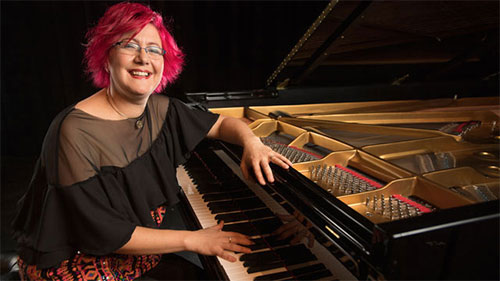Shpachenko’s soccer-inspired program gets yellow flag for mixed music
Plenty of musicians are sports fans, but that personal aspect doesn’t come out often in classical music. Charles Ives, who was a serious athlete when he was young, wrote pieces that tried to emulate the experiences of playing baseball and football.
Pianist Nadia Shpachenko ventured her own contribution at Bargemusic Friday evening, with a program she titled “GOAT”, a set of nine new and recent pieces that were, in one way or another, about soccer.
These were pieces Shpachenko requested (with support from New Music USA) around the idea of the “beautiful game.” That was intriguing on the surface for this musician, who has superb technique and a spirit of fun around her playing, two things one would hope for in athletics as well.
Along with the soccer theme, much of the music concerned electronics, mixing non-acoustic sounds and processes with the piano. These two themes came together, though not always synchronized and with varying levels of success.
Electronics are always welcome with the piano, which despite its strengths, can’t modulate dynamics, timbre, nor expression after notes are struck. The primary disappointment of the evening was that the electronic components were all pre-recorded, with no real-time signal processing. Chalk that up to unfounded expectations.
The soccer connection was more central, and if one couldn’t feel any presence of the sport in the music, that was possibly due to one’s low level of interest in the sport.
In purely musical terms, there were fine, satisfying works from Ian Dicke, David Sanford, Pamela Z, and Adam Schoenberg. Dicke’s and Z’s pieces had an electronic component, the others were acoustic.
Dicke’s Telstar Lopps, named after a famous soccer ball design, opened the program, with piano accompanied by (pre-recorded) audio. The electronic part had processed piano sounds that, for example, crescendoed as they were sustained, or modulated timbres. This was a nice balance with what was a well-crafted variation form in three movements. Variations were a clever way to outline the different perspectives of a physical object.
David Sanford’s La Pulga Variations were more conceptually abstract and musically concrete. This seven-movement piece covered different historical aspects of soccer, from personalities and famous moments to styles of play. Sandford’s manner was baroque-ish, heavily contrapuntal, transparent, smart, and full of fine detail, and also covered the broadest range of moods of the evening. Shpachenko gave it a sparkling performance.
The pianist explained that Balón, by Z, was a piece the two of them play in performance, where there are enough variables that it comes out differently every time. Playing solo, she was accompanied by pre-recorded Z, the composer singing and speaking, describing the geometry of a soccer ball. There was a game-like interplay between the two parts, the piece was lovely and playful as musical idea passed back and forth between piano and audio.
Schoenberg’s Last Dance, an expressive, bittersweet ode to the inevitable finale of every athlete’s career. This was another well-made piece, musical, rather than narrative, in thought, and the pianist played it like she heard the lyrics of a ballad in her head. Last Dance, appropriately, closed the concert, and was a good wrap-up and an even better save for a concert that also had some problems.
One was length—the last piece came after one and three-quarters hours, without intermission, and by then one felt that the theme of soccer confined the emotional and intellectual scope of the overall program.
Also some of the composers seemed uncomfortably limited. Christopher Cerrone’s Corridor of Uncertainty used piano and electronics to set up the anxiety that can fall between the goalie and defenseman when the ball is between them. Cerrone can usually be counted on for surprises. but this work just prodded the same idea over and over.
That was also the problem with The Hand of God by Oliver Dubon, which had the ambition of somehow expressing the anti-colonial spirit of the Argentina-England World Cup match in 1986. That would be a tall order for any composer, and Dubon’s piece was merely an exercise in agitation, often on only one or two notes.
Evan Ware’s Skillset and Tom Flaherty’s Goal Mining likewise tried to convey soccer practice and a match itself in music, which meant obvious clichés that neither felt like a team sport nor involving music.
Meanwhile, Dana Kaufman’s Honeyball was lost within its own concept, a polemic against the snobbish objections in England at the establishment of the first women’s soccer team in 1895. One thinks there are more resonant and pressing current issues to attack in the sport, and the piece had a fatal flaw between the second and final section, where Shpachenko had to get up from the piano, put on white gloves and change her shoes for soccer cleats. It’s the kind of thing that deflates the attention and does nothing for the music.
In the end, some exceptional and inspired play was undermined by several errors of judgement. The score, after extra time, was 0-0.
Musicians from The Knights play music around the idea of “The Sea,” 7 p.m. July 28 bargemusic.org




Posted Jul 23, 2022 at 3:31 pm by USWNT
“There are more resonant and pressing current issues.” Perhaps after professing ignorance of the sport I would have refrained from commenting on the state of the sport.